How real is Seasonal Affective Disorder or “SAD”? My husband and I joke about the winter blues and craving pasta, but my energy and enthusiasm levels really do change each winter. Is this lull I feel more than just holiday stress or not getting enough vitamin D?
AAS
Dear AAS,
Seasonal Affective Disorder, or SAD, has been a diagnosed by physicians and mental health clinicians since 1987. Though some people might get “the holiday blues,” actual SAD is far more serious and painful for those who experience it. Fortunately, there are several effective treatment options.
SAD is a type of depression that consistently occurs in a seasonal pattern; typically fall and winter. There are also some who experience it in the spring. SAD is more common among women than men and the rates vary depending on location and distance from the equator. Other risk factors for SAD include: people aged 18 to 55, those with a history of depression, bi-polar disorder or having a relative with bi-polar disorder.
SAD shares symptoms with “regular” depression, including feeling sad, moody, or anxious, experiencing a loss of interest in usual activities, craving carbohydrates, sleeping more and still feeling tired, and having difficulty concentrating. The degree of these symptoms can vary from person to person.
It is unclear exactly why some people experience SAD while others do not. Generally, there are three conditions believed to contribute to SAD: a lack of sunlight (upsetting a person’s natural circadian rhythms), a decrease in serotonin levels (a neurotransmitter that plays a role in regulating mood), and a disruption in the body’s level of melatonin which effects sleep patterns.
Treatment options for SAD depend on the degree of the symptoms. Some people can simply adjust their eating and sleeping patterns to compensate. Others may benefit from more formal treatments such as phototherapy, using a light box or dawn simulator, temporary use of anti-depressant medications, or specific forms of talk therapy.
This said, some recent research appears to refute the existence of SAD, finding no difference between it and general depression. These results came from a study out of Auburn University that looked at many variables thought to be linked to SAD: time of year, latitude, and the amount of sunlight exposure.
So, the jury is still out on SAD; but not on depression.
If you recognize a seasonal change in your mood and can manage your symptoms, you are fortunate. However, at any time of year if you are unable to manage feelings of depression on your own or if other parts of your life are negatively impacted (or if you ever think of suicide), speak with a physician or mental health counselor. Treatment is available, it works, and people recover.
Cindy Goodwin is the director of Mercer Island Youth and Family Services. The advice offered by YFS is intended for informational purposes only and to guide you in seeking further resources if needed. The answers to questions are not intended to replace or substitute for any professional, psychological, financial, medical, legal or other professional advice. If you have a question you would like to ask Cindy to answer in this column, or if you need additional professional resources, email miyfs@mercergov.org.



